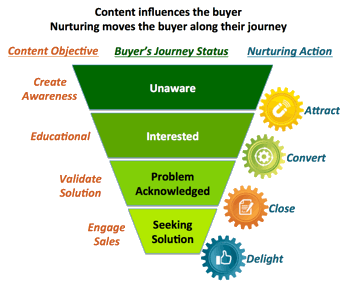
Let’s start with the assumption that your website is attracting visitors. Not just random visitors, but the right visitors who have genuine interest in the products and services provided by your business. Some of these visitors are first-timers, looking for general information. Others are repeat visitors, returning for more details. But all of these visitors remain anonymous (which means none of them can be courted as leads!) until they choose to provide contact information in exchange for your premium level content, blog updates, newsletter subscriptions, or other offers.
When website visitors opt to share their contact information, they open the door for you to begin the lead nurturing process.
According to the Oxford Dictionary, to nurture is to “care for and encourage the growth or development of” someone or something. The concept of lead nurturing is well aligned with this definition as follows:
- Lead nurturing encourages the growth and development of leads into customers through personalized interactions that build trust.
- Lead nurturing demonstrates care and understanding of each lead’s needs by offering highly relevant information at the right time during the purchase decision process.
Today’s B2B buyers interact with vendors differently than in the past, proceeding more independently through the Buyer’s Journey and deferring direct contact with vendors until they are closer to their decision points. In response, vendors are turning to Inbound Marketing strategies to attract and nurture leads without early sales intervention.
When implemented correctly, automated lead nurturing emulates the best practices of your top-performing salespeople, doing what they would do when they have access to leads in the early stages of the purchase process.
Lead nurturing has three main goals:
- To provide leads with the information and resources they need to move forward through the Buyer’s Journey
- To build relationships between your business and each of your leads
- To produce sales-qualified leads that are ready to convert to new customers
Increasingly, lead nurturing is taking place across multiple digital platforms to reach leads whenever and wherever they are available. However, the foundation for an effective lead nurturing program lies in a comprehensive email drip campaign in which awareness, consideration, and decision stage content is delivered directly to leads based on their positions in the Buyer’s Journey.
The following are key considerations for successful lead nurturing through an email drip campaign:
- In order to keep leads engaged and moving forward in the buying process, it is essential to determine what information is most relevant to each lead and then deliver that information precisely when needed.
- For targeted nurturing, segment your leads into three groups according to each lead’s position in the Buyer’s Journey:
- Awareness Stage - Leads who are researching the cause of a business problem
- Consideration Stage - Leads who understand the cause of the problem and are researching solutions
- Decision Stage - Leads who have decided to implement a solution that is offered by your business
- Further refine each lead segment based on demographic data (industry, business size, job title, etc.) as well as buyer behaviors tracked through website browsing history, Call-To-Action click-throughs, opened emails, social media activity, and other digital footprints.
- Use lead scoring to rank your leads. Assign scores according to relevant criteria such as position in the Buyer’s Journey, potential lifetime value, and other demographic and behavioral criteria used for lead segmentation. Define score thresholds to trigger the next automated email or to indicate sales readiness. Lead scoring takes lead segmentation to the next level, providing a methodology for prioritizing leads based on objective measures of both their sales readiness and their value to your business.
- Pay close attention to lead responsiveness. Identify patterns of lead behavior and look for outliers. Recognize and respect the fact that leads travel through the Buyer’s Journey at different speeds, but don’t allow leads to drop out completely without trying to re-engage them in the process!
- Insure that the content of every email message is highly relevant, educational, and easy to share!
- Keep in mind that lead nurturing doesn’t end when a lead becomes a customer. Continue nurturing your existing customers as leads for repeat sales.
A comprehensive Inbound Marketing program with automated lead nurturing will help your business attract and convert sales-qualified leads with increased efficiency and higher success rates. To discover more tips on how to leverage your marketing activities for greater business growth, please download our whitepaper “Stand Out From The Crowd: 24 Tips to Set Your Company Apart”.


